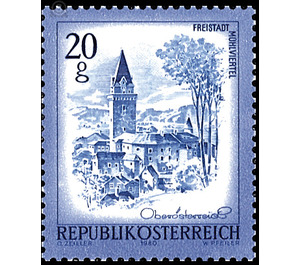landscapes - Austria / II. Republic of Austria 1980 - 20 Groschen
Theme: Architecture
| Country | Austria / II. Republic of Austria |
| Issue Date | 1980 |
| Face Value | 20.00 |
| Color | violet |
| Printing Type | combination printing |
| Stamp Type | Definitive |
| Item Type | Stamp |
| Chronological Issue Number | 992 |
| Chronological Chapter | OOS-OE2 |
| SID | 240661 |
| In 69 Wishlists | |
Freistadt is the largest city of the Mühlviertel, that part of Upper Austria between the Danube in the south and the former CSSR in the north. Freistadt was always border town, and this fact has also decisively shaped its history. On an ancient trade route, which led from the mouth of the Enns into the Danube already in Roman times to Bohemia and further up to the Baltic Sea, the city was created. It is believed that the city of Babenberger Duke Leopold VI. (1198-1230) was founded around the year 1220. The city was supposed to be a bulwark against the restless Bohemian border, but also, as the property of the Babenbergs, was to put a stop to the advance of the Passau bishops. The foundation of the city's rapid economic development was laid by King Rudolf von Habsburg, who lent the right to deposit and stack in 1277. The keep, which can be seen as a trademark, is considered the landmark of the castle Freistadt and is a remarkable and precious piece of the city. In its present appearance, it was created under Rudolf the donor. He is 50 m high. The steep roof with the four bay-shaped masonry roof windows gives the almost windowless square tower its splendid appearance.


